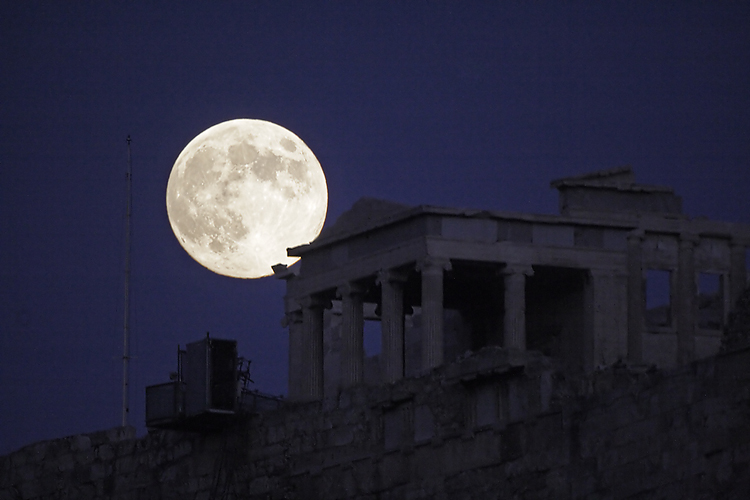
Our closest celestial neighbour has kept us company for at least four billion years and has entertained our imagination in a variety of
ways. It certainly has been involved in our maturation as a species with man's first step on a body beyond our planet during the latter
part of the twentienth century and will, inevitably, be our first stop prior to any sort of manned travel to a further celestial body
such as Mars. The moon has been a great source of education about our own planet's evolutionary history; it has entertained many
inquisitive minds from earlier cultures and generations about the universe in general and man's role in particular; it has enriched the
minds of young children taking their first look through a telescope and continues to impact our lives in ways we may or may not readily
recognize including tidal forces and various natural rhythms and cycles.
Note: The image below is a follow-up to other similar efforts involving the rising (full) moon near dusk and
against well-known landmarks in Greece including archaeological grounds (see
here). Such an exercise requires careful planning and execution
so that the azimuth and altitude of the rising moon match precisely with the foreground landmark of interest. Also important is the time during
late afternoon that such an attempt is executed, for one requires balanced lighting between the foreground landmark and the bright rising
(full) moon. Once all of these factors are available simultaneously with respect to lighting balance (full moon and landmark foreground) as
well as azimuth and altitude, a result such as the one below involving the Propylaea to the Temple of Poseidon Erechtheus at the Acropolis of
Athens is realized.
The Erechtheum was built between 421 and 407 BC and is named after one of the Acropolis gods, namely Erechtheus. The southern side is perhaps
the most recognized aspect of the Erechtheum, for it is characterized with the stunning
Caryatids. The immediately opposite side is dedicated to the Acropolis gods
Poseidon and Erechtheus and who fought unsuccessfully against Athena for the privilige of protecting the city of Athens. This (northern) facade
of the Erechtheum is adorned with stunning ionic marble columns which grace the Propylaea and in turn introduce the visitor to the Temple of
Poseidon Erechtheus itself. The image below was taken from a distance of approximately 600 meters to the northwest of the Acropolis in an effort
to match as closely as possible the apparent diameter of the rising full moon with that of the propylaea.
Note: For additional photos of the rising moon from the same session as well as photos of the sun and/or full moon
against other well-known Greek archaeological grounds and sites, please click
here.
|
Body: Moon Mass: 0.0123 x Earth Mean Eq Diameter: 0.2719 x Earth Distance: 364,484 km Sidereal Rev: 27d 07h 43m 11s Age: 14d 18h 03m Phase: 99.7° Diameter: 32.99' Magnitude: -12.6 Rukl: N/A |
 |
Date: Aug 20, 2013 Location: Athens, Greece Equipment: LZOS MC 3M-5CA 500/f8 Canon EOS 350D Exposure: 1 x 1/80 sec ISO 400 RAW Image Format 3456x2304 image size Manual Mode Servo Mode Software: Digital Photo Pro V2.1.1.4 Photoshop CS5 Processing: Resampling JPG Compression |